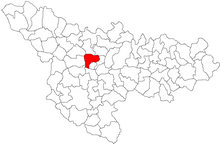Dumbrăvița (Timiș)
|
Dumbrăvița Neusentesch, Neu-Sentesch Újszentes |
||||
|
||||
| Basic data | ||||
|---|---|---|---|---|
| State : |
|
|||
| Historical region : | Banat | |||
| Circle : | Timiș | |||
| Coordinates : | 45 ° 48 ' N , 21 ° 15' E | |||
| Time zone : | EET ( UTC +2) | |||
| Area : | 18.98 km² | |||
| Residents : | 7,522 (October 20, 2011) | |||
| Population density : | 396 inhabitants per km² | |||
| Postal code : | 307160 | |||
| Telephone code : | (+40) 02 56 | |||
| License plate : | TM | |||
| Structure and administration (as of 2016) | ||||
| Community type : | local community | |||
| Mayor : | Malac Victor ( PSD ) | |||
| Postal address : | Strada Petofi nr 31 loc. Dumbrăvița, jud. Timiș, RO-307160 |
|||
| Website : | ||||
Dumbrăvița (also Szentesul Nou , German Neusentesch , Neu-Sentesch , Hungarian Újszentes or Vadászerdőközség ) is a municipality in the Timiș district , in the Banat region , in southwest Romania .
Neighboring places
| Sânandrei | Covaci | Giarmata |
| Timișoara |

|
Giarmata-Vii |
| Timișoara | Timișoara | Ghiroda |
history
After the Austro-Hungarian settlement of 1867, when the Banat was annexed to the Kingdom of Hungary , the Hungarian government founded several villages in the vicinity of Timisoara and settled them with Hungarians from the Szeged area.
In 1889, 127 people from Szentes bought land six kilometers north of Timisoara, which they had to pay off within 20 years according to the contract. The land was on a cleared area of the hunting forest (Romanian: Pădurea Verde, Hungarian Vadászerdő). So the place got the name Vadászerdőközség (German: village in the hunting forest , Romanian: Comuna din Pădurea Verde ).
In autumn 1891 133 families, a total of 768 people from Szentes, built houses here. In 1892, at the request of the inhabitants, the village was named Újszentes (German: Neuszentes , Romanian: Szentesul nou ). The majority of the residents were of the Reformed faith; In 1901 the Reformed Church was consecrated.
The Treaty of Trianon on June 4, 1920 resulted in the Banat being divided into three parts , which resulted in Dumbrăvița falling to the Kingdom of Romania . After 1920, several families from the Serbian Banat, from Greater Torak and Little Torak , but also Romanian and Hungarian families from other parts of the country settled. In 1950 the place name was changed to Dumbrăvița .
Since 2015 Dumbrăvița has been connected to the Timișoara trolleybus network by the M14 line of the Societatea de Transport Public Timișoara .
Population development
| census | Ethnicity | |||||||
|---|---|---|---|---|---|---|---|---|
| year | Residents | Romanians | Hungary | German | Other | |||
| 1900 | 1151 | 46 | 1042 | 58 | 5 | |||
| 1930 | 1490 | 381 | 995 | 109 | 5 | |||
| 1977 | 2978 | 1157 | 1687 | 100 | 34 | |||
| 2002 | 2693 | 1576 | 1054 | 32 | 1 | |||
| 2011 | 7522 | 5722 | 1057 | 87 | 656 (59 Serbs ) | |||
Web links
Individual evidence
- ↑ a b 2011 census in Romania ( MS Excel ; 1.3 MB)
- ↑ Mayoral elections 2016 in Romania ( MS Excel ; 256 kB)
- ↑ a b c d History of Dumbrăvița at dumbravitatimis.ro ( Memento of the original from January 12, 2014 in the Internet Archive ) Info: The archive link was inserted automatically and has not yet been checked. Please check the original and archive link according to the instructions and then remove this notice. (Romanian)
- ↑ kia.hu , (PDF; 982 kB) E. Varga: Statistics of the number of inhabitants by ethnic group in the Timiș district according to censuses from 1880 - 2002








